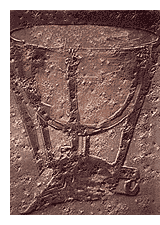|
INTRODUCTION TO TYMPANI TECHNIQUE |
|
It is said that Toscanini used to call the tympani, “the
 backbone of the orchestra.” While another famous conductor asserted that the timpanist is “the orchestra's second conductor.” backbone of the orchestra.” While another famous conductor asserted that the timpanist is “the orchestra's second conductor.”In addition to performing the traditional musical functions of the instruments that predominantly operate in the grave register, the tympani represent a constant rhythmic reference point for the orchestra, like the drum set in jazz and light music. The origins of the tympani must be sought in very remote times because these instruments are a special evolution of several models of drum. The first attempts to change the range of the skin by the various means available (cord tighteners or simple hand pressure) represent the first phases in the diversification between several membrane instruments with indeterminate sounds and the tympani. According to our study and research, the true ancestor of the tympani was a drum that was used in Sumerian religious ceremonies about five thousand years ago (pp. 48-49 1st vol. of "L’Arte della percussione," Milan 1965). This instrument, which consisted of an ox hide stretched over a copper kettle, could, as you would imagine, only make the low, harmonically rich sounds of current leading models that are still assembled from copper kettles and natural skins. Today, the modern method for tensioning the skins consists of a pedal connected to coupling screws. The range is related to the diameter of the kettle and in standard models reaches about a sixth. The number of instruments that are used in an orchestra can vary depending on the selections that have to be performed. In general, three or four tympani are used for “routine” work. With four tympani you make more arm movements while with three you work in smaller area but have to make more pedal changes. The basic tympani techniques are roughly the same as the snare drum but, whether due to the different response of the skin or the difference in touch, they are executed differently. Among the principal, fundamental tympani techniques, we can list: the alternating hands technique which includes the single-stroke roll, crossover and withdrawal (these latter being necessary to avoid too many double strokes), the double stroke technique also including double-stroke rolls and paradiddles, the damping technique which is very important for stopping vibrations and giving notes their proper value, and the pedal technique indispensable for changing notes. |